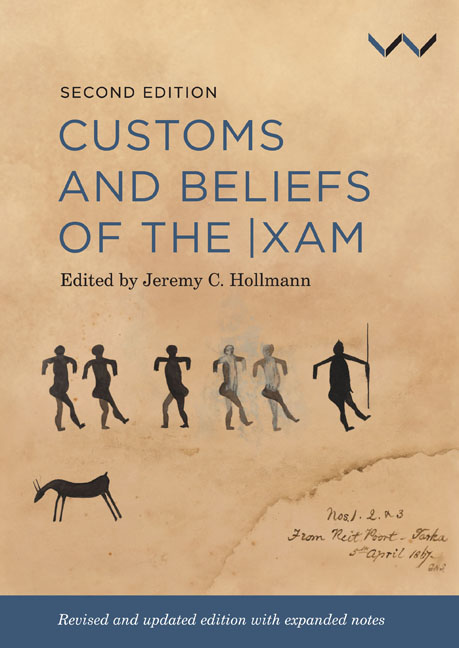Book contents
- Frontmatter
- Dedication
- Contents
- Acknowledgements
- Foreword To The Second Edition
- Foreword To The First Edition
- Introduction
- Contributors
- The |Xam Language
- The People In The Notebooks
- Part 1 Baboons
- Part 2 The Lion
- Part 3 Game Animals
- Part 4 Omens, Windmaking, Clouds
- Part 5 Rain
- Part 6 Rainmaking
- Part 7 Sorcerers
- Part 8 More About Sorcerers and Charms
- Part 9 Special Speech of Animals and Moon
- Appendix 1 |Xam Grammar
- Appendix 2 Summary of The Narratives
- References
- Index
Part 2 - The Lion
Published online by Cambridge University Press: 24 November 2023
- Frontmatter
- Dedication
- Contents
- Acknowledgements
- Foreword To The Second Edition
- Foreword To The First Edition
- Introduction
- Contributors
- The |Xam Language
- The People In The Notebooks
- Part 1 Baboons
- Part 2 The Lion
- Part 3 Game Animals
- Part 4 Omens, Windmaking, Clouds
- Part 5 Rain
- Part 6 Rainmaking
- Part 7 Sorcerers
- Part 8 More About Sorcerers and Charms
- Part 9 Special Speech of Animals and Moon
- Appendix 1 |Xam Grammar
- Appendix 2 Summary of The Narratives
- References
- Index
Summary
People have always had to contend with lions (Panthera leo). These large predators are superbly equipped for killing, especially at night: their eyes are perfectly adapted for night vision and their massive strength allows them to overpower the strongest prey. They are intelligent too: they devise strategies appropriate to the kind of prey they are hunting. African lions hunt anything, from tortoises and porcupines to elephant and buffalo (Mills & Harvey 2001). They also kill people.
These natural historical details about lions would, of course, have been common knowledge to |xɑm people, who had lived with lions for generations (see Marshall Thomas [1995] for a fascinating analysis of the relationship between lions and the Ju|ʼhoɑnsi of the Kalahari). For the |xɑm, however, these feline behavioural characteristics spoke of the lion's powers. The narratives in Part 2 detail many of these extraordinary abilities.
Lions are people too
The |xɑm saw certain similarities between themselves and lions. Many of these parallel the observations that both humans and lions are hunters and that sorcerers (ǃgiːtǝn) and lions are nocturnal. Diäǃkwɑin mentions two further likenesses in behaviour: neither humans nor lions eat game where they have killed it, and both groups remove the animal's stomach contents before eating their prey (Narrative 2.3). According to ‖kɑbbo, lions have the same family structure as humans, with families of grandparents, mothers, fathers and grandchildren. People can identify the family status of an individual lion by the amount of hair on its body and its colour, as well as by how, where and what the particular lion hunts (A2.1.024, L.II.18: 1638–1646, 1650–1653). Furthermore, lions understand human speech (Lewis- Williams 2000: 176) and are able to imitate it (Narrative 2.1). They also speak to each other (A2.1.022, L.II.16: 1554–1555), something which their prey, the eland (Taurotragus oryx), hartebeest (Alcelaphus buselaphus) and gemsbok (Oryx gazella) rarely, if ever, do. Lions, in ‖kɑbbo's words, ‘are also people’ (A2.1.022, L.II.16: 1551).
However, like baboons (see Part 1), lions are ‘people that are different’; moreover, they are ‘things which are angry’ (A2.1.022, L.II.16: 1552) because they kill and eat people. This fundamental attribute of lions figures large in |xɑm thought, and understandably so; few things can be more terrifying than being carried away at night and eaten by a great carnivore.
- Type
- Chapter
- Information
- Customs and Beliefs of the |xam , pp. 67 - 108Publisher: Wits University PressPrint publication year: 2022



